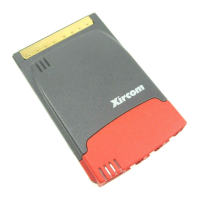
Do you have a question about the Xircom RealPort CardBus Ethernet 10/100 + Modem 56 and is the answer not in the manual?
Steps to install the hardware and network cabling, followed by software installation chapters.
Features Xircom BatterySave™ technology for maximum battery life when the network cable is detached.
Details optional ISDN, Digital Wireless, and Analog Cellular Connection Kits for enhanced communication.
Lists items included with the RealPort CardBus Ethernet 10/100+Modem 56, like the card, cables, and documentation.
Specifies the necessary network cables and connectors for 100Base-TX and 10Base-T Ethernet connections.
Instructions on how to physically insert the CardBus adapter into a PC Card slot.
Outlines Plug and Play installation for Windows 98 and Windows 95 (OSR2+).
Lists the NDIS3, NDIS4, and 32-bit ODI drivers supplied for Windows 95 and 98.
Directs users to the HELPDOCS.HLP file for instructions on using the 32-bit ODI client driver in Windows 95.
Details installation for Windows 95 OSR2 and later, noting enhanced support for CardBus devices.
Explains that COM5 is assigned by default and how to change it using Xircom COM Port Selector.
Provides instructions to create installation floppy disks from the Xircom CD-ROM using MAKEDISK.BAT.
Step-by-step guide for inserting the PC card into the slot while Windows is running.
Offers solutions for modem initialization errors and connection failures, suggesting a "Generic Hayes compatible" device.
Explains how to configure driver parameters like CableDetect, LineSpeed, and LineMode via the Network Control Panel.
Lists the CBE.SYS, CBEN4.SYS, and CBMODEM.SYS drivers found on the Xircom CD-ROM for Windows NT.
Describes the manual installation process for the RealPort CardBus Ethernet 10/100+Modem 56 in Windows NT 4.0.
Guides users through setting up the modem in Windows NT after the network adapter installation.
Details configurable driver parameters for Windows NT, such as InterruptNumber, InterruptStyle, and LineMode.
Recommends consulting computer/network docs, README file on CD-ROM, and the Xircom website for support.
Explains the availability of Windows-based and DOS-based diagnostic programs to test adapter functions.
Provides steps to run the CBEDIAG.EXE program for diagnosing issues on Windows systems.
Details how to run the CBETEST.EXE program from the MS-DOS command line for diagnostics.
Offers advice for resolving issues, including checking README, drivers, network connections, and testing on different computers.
Defines various keywords and parameters used in driver configurations and troubleshooting.
Outlines Xircom's offerings including phone support, software updates, BBS, and World Wide Web access.
Explains how to obtain warranty coverage and service, directing users to contact Xircom support.
Guides users on downloading drivers from the Xircom website and through the Bulletin Board System (BBS).
Provides contact details for Xircom's customer support in the Americas, including phone, fax, email, and web.
Lists contact information for Xircom Europe's customer support, including phone numbers for different languages and email.
Details customer support contacts for Xircom in the Asia Pacific region, including Singapore and Australia.
Provides contact information for Xircom's customer support in Japan.
Information on accessing Xircom support through local resellers and the World Wide Web.
Details physical and environmental specifications like type, connectors, size, weight, operating/storage conditions, and memory.
Lists power consumption details for different modes (10Base-T, 100Base-TX, Modem only, etc.).
Covers modem capabilities, including data and fax modulation standards and error control.
Explains the hardware and software warranties provided by Xircom to the original purchaser.
Outlines user responsibilities for maintaining warranty rights, including reading documentation and proper usage.
Details the process for obtaining warranty service, including contacting support and obtaining an RMA number.
Lists exclusions and limitations of the warranty coverage, such as damage from misuse or unauthorized repairs.
States Xircom's declaration that the equipment complies with US Code of Federal Regulations, Title 47 Part 15, Subpart B.
Provides information on compliance with FCC Part 15 for Class B digital devices and associated warnings.
Outlines FCC Part 68 requirements for modem connection to the telephone network, including user responsibilities.
Presents Industry Canada (IC) notices regarding radio noise emissions and telecommunications network requirements.
Declares conformity with European Council Directives and compliance with EN 55022 and EN 50082-1 standards.
Explains the EU-wide standard for connecting telecommunications equipment to public switched telephone networks.
Declares the countries where the product is designed to work on PSTNs and potential interworking difficulties.
Provides safety warnings related to using the card with UL-listed computers and PC card slots.
Details compliance conditions for connecting terminal equipment to New Zealand's network.
Specifies the terms for government use, duplication, and disclosure of the software and documentation.